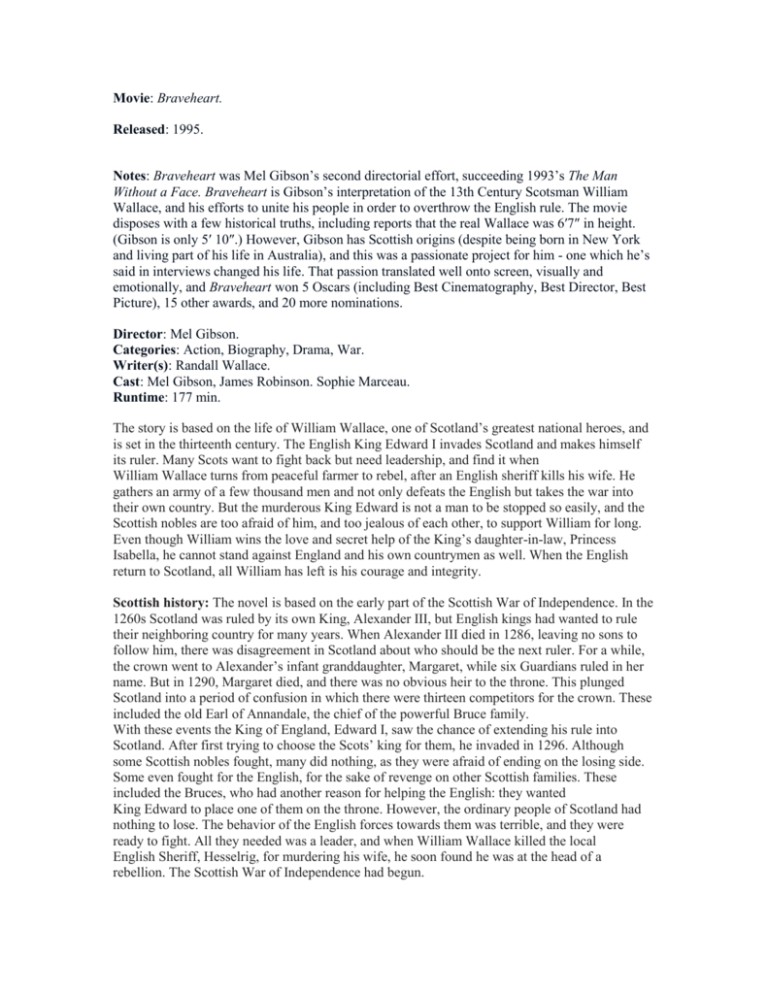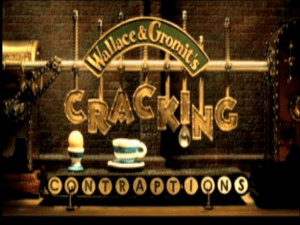Movie: Braveheart
advertisement

Movie: Braveheart. Released: 1995. Notes: Braveheart was Mel Gibson’s second directorial effort, succeeding 1993’s The Man Without a Face. Braveheart is Gibson’s interpretation of the 13th Century Scotsman William Wallace, and his efforts to unite his people in order to overthrow the English rule. The movie disposes with a few historical truths, including reports that the real Wallace was 6′7″ in height. (Gibson is only 5′ 10″.) However, Gibson has Scottish origins (despite being born in New York and living part of his life in Australia), and this was a passionate project for him - one which he’s said in interviews changed his life. That passion translated well onto screen, visually and emotionally, and Braveheart won 5 Oscars (including Best Cinematography, Best Director, Best Picture), 15 other awards, and 20 more nominations. Director: Mel Gibson. Categories: Action, Biography, Drama, War. Writer(s): Randall Wallace. Cast: Mel Gibson, James Robinson. Sophie Marceau. Runtime: 177 min. The story is based on the life of William Wallace, one of Scotland’s greatest national heroes, and is set in the thirteenth century. The English King Edward I invades Scotland and makes himself its ruler. Many Scots want to fight back but need leadership, and find it when William Wallace turns from peaceful farmer to rebel, after an English sheriff kills his wife. He gathers an army of a few thousand men and not only defeats the English but takes the war into their own country. But the murderous King Edward is not a man to be stopped so easily, and the Scottish nobles are too afraid of him, and too jealous of each other, to support William for long. Even though William wins the love and secret help of the King’s daughter-in-law, Princess Isabella, he cannot stand against England and his own countrymen as well. When the English return to Scotland, all William has left is his courage and integrity. Scottish history: The novel is based on the early part of the Scottish War of Independence. In the 1260s Scotland was ruled by its own King, Alexander III, but English kings had wanted to rule their neighboring country for many years. When Alexander III died in 1286, leaving no sons to follow him, there was disagreement in Scotland about who should be the next ruler. For a while, the crown went to Alexander’s infant granddaughter, Margaret, while six Guardians ruled in her name. But in 1290, Margaret died, and there was no obvious heir to the throne. This plunged Scotland into a period of confusion in which there were thirteen competitors for the crown. These included the old Earl of Annandale, the chief of the powerful Bruce family. With these events the King of England, Edward I, saw the chance of extending his rule into Scotland. After first trying to choose the Scots’ king for them, he invaded in 1296. Although some Scottish nobles fought, many did nothing, as they were afraid of ending on the losing side. Some even fought for the English, for the sake of revenge on other Scottish families. These included the Bruces, who had another reason for helping the English: they wanted King Edward to place one of them on the throne. However, the ordinary people of Scotland had nothing to lose. The behavior of the English forces towards them was terrible, and they were ready to fight. All they needed was a leader, and when William Wallace killed the local English Sheriff, Hesselrig, for murdering his wife, he soon found he was at the head of a rebellion. The Scottish War of Independence had begun. Brave heart: Wallace gives the Scots courage. While the Scottish nobles are busy looking after themselves, Wallace puts all his energy into fighting for Scotland and its people. Freedom and independence: Wallace teaches the Scottish people to value their freedom and their independence above all else. Wallace makes Robert the Bruce, who in fact becomes the King of Scotland later on, ashamed of his homage to English. After Wallace’s death, Robert the Bruce was ready to make his contribution to reassert the independence of Scotland. In 1306, Robert the Bruce had himself crowned King of Scotland and led another revolt. Under his leadership, at the Battle of Bannockburn in 1314, the Scots defeated the largest army England had ever put into battle. Scotland won its freedom for the next 400 years. The thistle: The thistle, a pale purple flower like an artichoke, is the national symbol of Scotland, and this flower is used effectively in the story, describing not only Wallace’s love for his wife but his loyalty to Scotland. Secret love: Even though it is not historically correct, the story shows that Princess Isabella secretly loves William Wallace and helps him. Being ignored by her effeminate husband, she wishes to conceive Wallace’s child. Her wish is granted. About the film Braveheart was one of the most popular films of 1995. Nearly three hours long, it cost about $53 million to make, and has been compared to the great historical epics of the 1960s, such as Spartacus, El Cid and Lawrenceof Arabia. It stars Mel Gibson as Wallace, French actress Sophie Marceau as Princess Isabella, and Patrick McGoohan as King Edward I. Gibson also directed and produced the film. The film was shot partly in Scotland and partly in Ireland, where 2,000 members of the Irish army were used as extras in the film’s very impressive battle scenes. It won the Academy Award for Best Picture in 1995.









